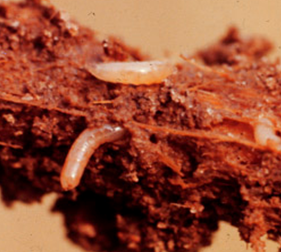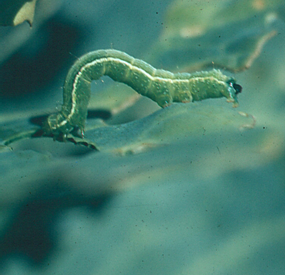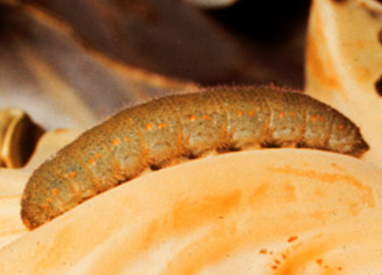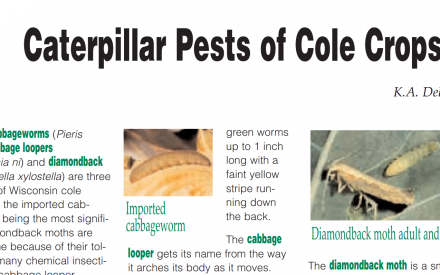
Authors: David Lowenstein and Russell Groves, UW-Madison Entomology
Last Revised: 05/22/2019
X-number: XHT1030
The cabbage maggot (Delia radicum) is an early season pest of cruciferous/cole crops (e.g., cabbage, broccoli, Brussels sprouts, cauliflower, kohlrabi, rutabaga, turnip, and radish), as well as cruciferous weeds (e.g., wild mustard, water cress, wild radish). Cabbage maggot damages plants by feeding on their roots and lower stems. Early season transplants and spring root crops are damaged most severely. Wounds produced by cabbage maggot feeding not only cause damage directly to plants, but can also provide entry points for a number of disease-causing organisms that can cause additional damage.
Appearance: The adult cabbage maggot is an ash gray, bristly fly that resembles a housefly, but is half as long and has black stripes on its thorax. Cabbage maggot larvae are 1/3 inch long (when mature), white and legless with bodies that taper toward their heads. These larvae look similar to seed corn maggots, but differ in terms of their feeding choices. Cabbage maggots prefer to feed on cruciferous plants, while seed corn maggots prefer to feed on seeds and seedlings of corn and cucurbits (e.g., cucumber, squash, pumpkin, watermelon).
Symptoms and Effects: Cabbage maggots feed both within and on the surface of roots. Their feeding wounds provide entry points for the organisms that cause diseases such as black leg and bacterial soft rot (see University of Wisconsin Garden Fact Sheet on Bacterial Soft Rot). Maggots can be especially damaging to seedlings, injuring the growing points of the roots and stunting plant growth. Injury to crops is more prevalent during wet, cool weather, which cabbage maggot prefers. Injured plants become off-color and may eventually wilt as daytime temperatures increase in late spring.
Life Cycle: Cabbage maggots overwinter as pupae in the upper few inches of the soil. Adults emerge in mid-May, about the same time that yellow rocket and forsythia are in bloom. Adults are attracted to freshly-tilled fields with decaying organic matter where they lay eggs on the soil near the base of cole crops and other cruciferous hosts. Eggs hatch in two to seven days and larvae immediately begin feeding on the roots of nearby host plants. Feeding continues for three to four weeks before larvae pupate in the soil. A second generation of adults emerges in late June and lays eggs which hatch producing additional larvae that feed and eventually pupate. Typically, this second set of pupae survives the winter. However, if warm weather extends the growing season, a third generation of cabbage maggot is possible and this third set of pupae survives the winter.
Scouting Suggestions: You can predict adult cabbage maggot emergence using a 43°F base temperature degree day model where calculations begin once the ground has thawed. First generation adults appear after 300 degree days have accumulated. Second and third generation adults appear after 1476 and 2652 degree days respectively have accumulated. For details on calculating degree days, see University of Wisconsin Garden Fact Sheet on Degree Day Calculation.
Alternatively, you can monitor for adult populations using yellow plastic bowls filled with soapy water. In larger plantings, place bowls every 100 ft. along field edges. Count flies every four to six days to determine if adult populations are increasing or decreasing.
Control
Cultural: Effective cabbage maggot control is primarily preventative. To avoid damage from this pest, till in any cover crops in fields to be planted to cole crops two to three weeks before seeding or transplanting. Also, DO NOT plant cole crops in fields where animal manure has been freshly applied. Be sure that soil temperatures are greater than 50°F at planting to promote quick emergence. Time planting to avoid peak cabbage maggot adult emergence. Plantings established after mid-June generally suffer less damage than plantings established earlier. Optimally, transplants should be planted one to two weeks before peak adult emergence.
Floating row covers can be effective in protecting plants during cabbage maggot flight periods. Diatomaceous earth, parasitic nematodes, and predaceous ground beetles may also help reduce cabbage maggot populations. Immediately after harvesting a cole crop, work crop residues into the soil to reduce sites where the cabbage maggot can overwinter.
Chemical: In areas where cabbage maggot has historically been a problem, consider using insecticides applied at planting as either a drench or band application. Apply this insecticide directly at the base of plants to avoid disrupting beneficial, soil-inhabiting insects. See University of Madison Division of Extension bulletin Commercial Vegetable Production in Wisconsin (2024) for detailed insecticide recommendations. Note that there are no insecticide options for treating cabbage maggot once an outbreak has started.
Download Article





 Cabbage Looper
Cabbage Looper Imported Cabbageworm
Imported Cabbageworm Cole Crops Disorder: Clubroot
Cole Crops Disorder: Clubroot Caterpillar Pests of Cole Crops
Caterpillar Pests of Cole Crops


